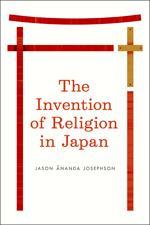I recently got a note from Jason A. Josephson, professor of religion at Williams College, announcing the publication of his new book, The Invention of Religion in Japan. As regular readers know, I’m a big fan of Jason’s work. In this post, I briefly discussed that work and cited two of his articles (both of which I regularly assign for my anthropology of religion course).

Jason’s book expands on his 2011 article “The Invention of Japanese Religions” and may also elaborate on his 2006 article “When Buddhism Became a ‘Religion’.” I say “may” because I just ordered the book and haven’t yet read it. Assuming that Jason’s articles are indicative of what we can expect, I wouldn’t be surprised if his book becomes something like a required text in the field of religious studies. If you haven’t read the articles, I encourage you to do so. You’ll see why ordering his book is a good idea.
The Invention of Religion in Japan comes at a particularly apropos time for my own research. I’ve decided that ancestral animism-shamanism is not “religion” and is not even what is sometimes called “proto-religion.” This latter term is especially bothersome because it implies some sort of teleology or progression whereby animism would naturally or inevitably give rise to “religion” proper. I reject this idea.
By extension, I don’t find post-Neolithic religious speculation or theology to be any more developed, sophisticated, elaborated, or advanced than that which can be found among animists (and especially shamans). Modern theologies may appear to be more sophisticated but this is largely due to the fact that there were no classes of animists who spent lifetimes cloistered away learning how to read traditions and then re-write them. Anyone who carefully considers the animist worldview will quickly come to appreciate its manifold complexities, which rival anything done in any “religion” over the past 10,000 years.
While what we today call “religion” was partially derived from the animist worldview, animism is much more than mere “religion.” It is a comprehensive and integrated way of perceiving and being in the world. No religion does this. Thus, while post-Neolithic religions may be partially derived from ancestral animism, the derivation is largely a matter of borrowing some things while rejecting what I consider to be the most compelling (and difficult for us to comprehend) aspects of animism.
Post-neolithic religions, in other words, are but partial (and perhaps pale) reflections of something much richer and deeper. I don’t mean anything mystical by this. I am only suggesting that the long historical process which gave rise to the concept and category of “religion” is sui generis. “Religion” was not the logical or predictable outcome of ancestral animism. While there are some similarities and descent relationships between animism and religion, I now consider them to be largely separate “things” (i.e., psychological and social formations).
Why the sharp divide between ancestral animism and post-Neolithic religion? Many factors account for this but the most important has to be that some aspects of animism became deeply entwined with politics and economy. This long-developing historical marriage eventually gave birth to a mutant formation that we now call “religion.” At various times and in various places this formation was deployed in the service of power, and at other times and places it was used to resist power. This is a dialectic that continues to this day.
I hope that Jason pardons my digression here, but I suspect that his book will in several (and subtle) ways support my pet hypothesis. What do you think?

